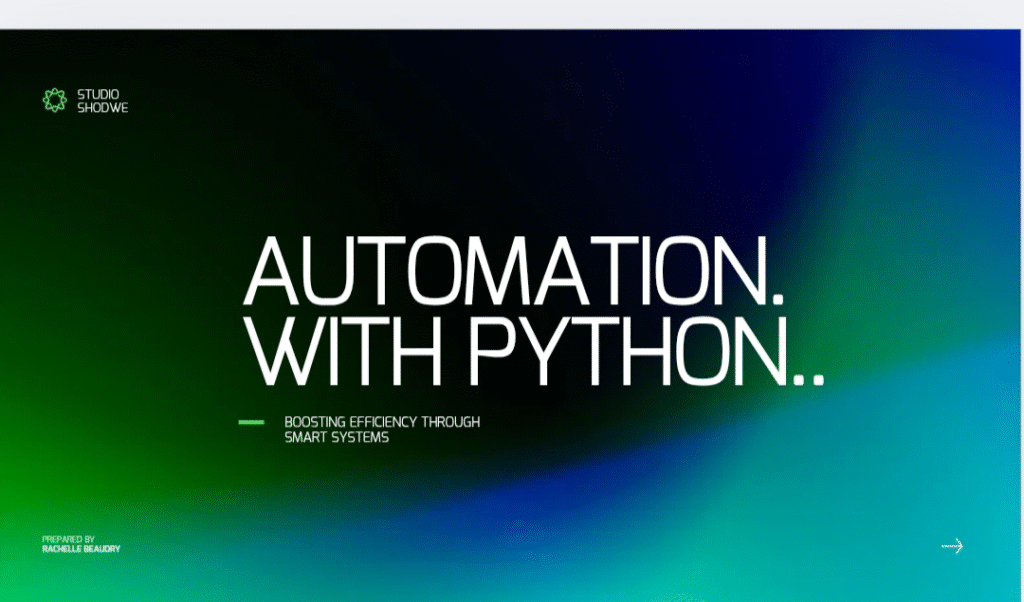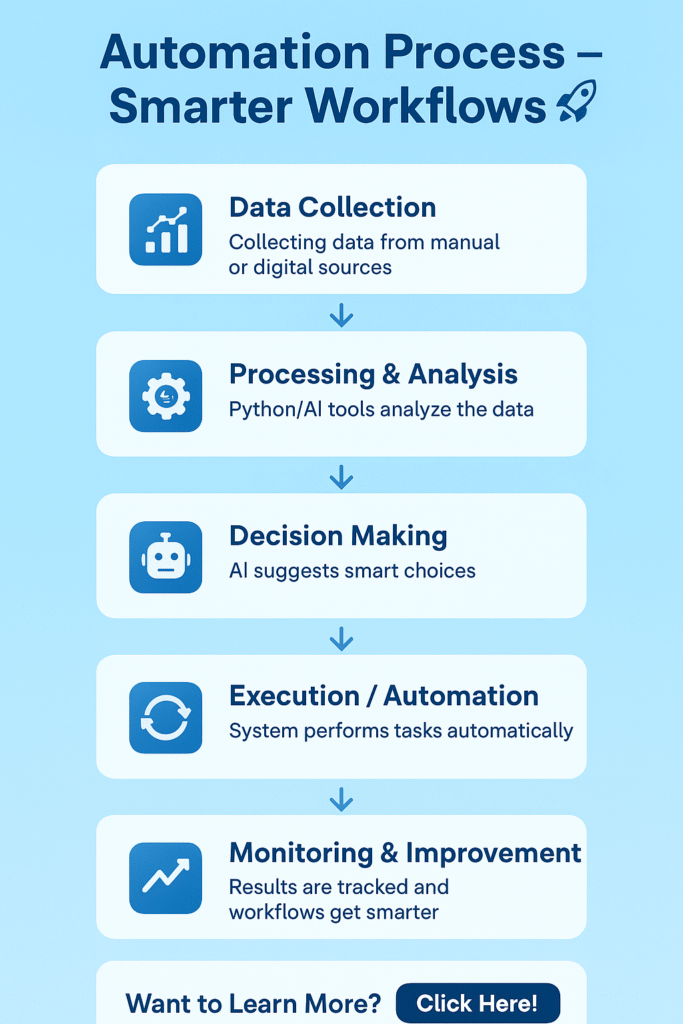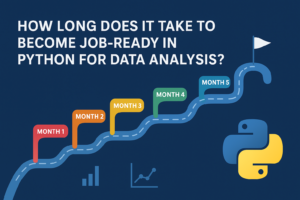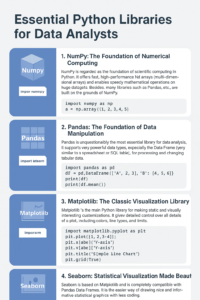From Python automation to AI-driven business solutions – How India is adopting automation at scale
Introduction – Why Automation is Booming in India
Automation, machine systems, and workflow structures are showing significant dynamics in Indian industries. Automation is spreading due to economic, digital, and workforce-driven factors. Labor fees in India have surged over time, while skill deficits continue in several domains, forcing organizations to diminish repetitive manual functions and foster efficiency through automation. Digital frameworks have been deployed across manufacturing, logistics, IT, banking, and retail, featuring sensors, robotics, and software-directed procedures. Government schemes, such as Make in India and Production-Linked Incentives (PLI), have supplied guidance and funding for structured operations. Indian IT firms have developed dexterity in robotic process automation, cloud-based functionalities, and software-driven solutions, serving both domestic and global stakeholders. Startups developing robotics, drone-based frameworks, and automated analytics have flourished, supported by financial networks and innovation hubs. Demand from digital services and e-commerce necessitates sustained, fault-free operations, which automation facilitates. During the COVID-19 pandemic, dependency on manual labor decreased as companies adopted automated and contactless frameworks. Automation adoption also reflects efforts to guard competitiveness against international manufacturing and service providers.
Machine learning and related data-driven functions shape decision-making, operational flexibility, and customer guidance. The scale of business data, including sales, operations, and consumer habits, has deepened, requiring frameworks capable of precise, timely analysis. Repetitive operations such as billing, customer support, and inventory handling have been facilitated through predictive structures, reducing functional faults and costs. Forecasting analytics support decisions for demand prediction, risk determination, and personalized service delivery. Customers increasingly expect fast responses and tailored assistance, which automated frameworks supply. Applications of these technologies include fraud detection in finance, predictive patient care in healthcare, supply chain optimization, and automated recruitment mechanisms. Implementation challenges involve high expenses for smaller organizations, data privacy hurdles, the necessity for skilled professionals, and potential biases in model outputs. The balance between quantitative precision and qualitative insight continues to form dilemmas in practical deployment, requiring ongoing assessment.
The shift from manual intelligence to workflow-guided frameworks involves structured sequences of tasks supported or executed by technology rather than relying exclusively on human judgment. Manual approaches rely on observation, experience, and analysis, which may be faulty or prone to mistakes. Workflow-driven frameworks formalize procedures, enable process tracking, and decrease dependency on individual skills while enhancing operational reliability. For instance, report preparation may shift from manual compilation to automated dashboards, customer queries may be directed through ticketing systems, and healthcare records may be analyzed using diagnostic support tools. Decisions regarding the degree of automation versus human intervention remain subject to operational, ethical, and practical considerations.
Observations from these trends suggest multiple points for discussion. Automation and workflow integration enhance efficiency but may diminish the scope for manual supervision. Predictive structures offer informed insights but may introduce bias or demand constant verification. Adoption of these mechanisms requires evaluating the balance of cost, benefits, and ethical concerns. In this scenario, organizations must examine how automation, machine learning, and workflow management can be executed effectively, while remaining aware of trade-offs and functional limitations.
What is Business Automation?
Business Automation uses technology to perform repetitive tasks. These tasks are rule-based or time-consuming. Minimal human intervention is required, which reduces errors and saves time. It includes process automation, marketing automation, sales automation, IT monitoring, and customer service systems. Employees can focus on strategic work. This allows higher-value tasks to be completed efficiently. Traditional Business Process Automation relies on fixed rules and sequences. It integrates systems like ERP and CRM. However, it lacks adaptability to changing conditions.
In India, automation provides measurable benefits such as cost reduction. Productivity and accuracy also improve. Scalability, better customer experience, competitive advantage, and workforce transformation are additional outcomes. Employees are freed from routine tasks. They can focus on problem-solving and operational management. Companies can expand efficiently while maintaining global-quality standards. Adoption requires careful balance. Human oversight and automated execution must be monitored. Reliable and sustainable operations depend on this balance.
AI Automation – Taking Business to the Next Level
AI-driven automation is advancing business operations. It improves efficiency. It enables smarter decisions. It personalizes customer experiences. Automation also supports 24/7 operations. It enhances scalability. It frees human talent for strategic roles. It allows creative work. Traditional automation follows fixed rules. It performs repetitive tasks consistently. AI automation adds intelligence. It can handle complex or unstructured tasks with minimal human input.
In India, AI automation has notable use cases. In finance, it supports fraud detection. It handles credit scoring and algorithmic trading. It provides 24/7 customer service. In retail and e-commerce, AI drives personalized recommendations. It optimizes supply chains. It adjusts pricing dynamically. It provides automated support. In healthcare, AI aids medical diagnostics. It supports telemedicine. It accelerates drug discovery. It manages hospital workflows. In IT, AI automates troubleshooting. It strengthens cybersecurity. It speeds up software testing. It reduces errors. Real-world success stories show measurable business impact. Companies achieve faster decision-making. They improve operational efficiency. They enhance customer engagement.

Automation with Python – The Foundation of AI Automation
Python is the foundation for AI automation. It is simple and readable. It has extensive libraries like NumPy, Pandas, OpenCV, and Selenium. Python automates repetitive tasks. It manages data workflows. It integrates with AI models for intelligent decision-making. It supports finance, marketing, operations, and customer service automation. It reduces errors. It saves time. Bridging Python with AI adds intelligence. Machine learning, NLP, and computer vision are included. It enables smarter automation. Examples include analyzing emails, predicting trends, and automating trading. OCR on documents is also possible. It reduces human intervention. Key tools include pandas, Selenium, PyAutoGUI, scikit-learn, TensorFlow, and transformers. They enable scalable solutions. They improve efficiency and cost-effectiveness.

AI Business Automation – Merging Intelligence with Efficiency
AI Business Automation combines artificial intelligence with traditional business processes.
AI Business Automation uses artificial intelligence. It works with normal business processes. It helps make these processes smarter. It allows tasks that were once performed manually to be executed automatically.Tasks that people used to do by hand can now be done automatically. This saves time. It reduces human effort. AI adds intelligence to these workflows, enabling smarter decision-making. AI makes workflows smarter. It can analyze data and learn patterns. This helps businesses make better decisions. This combination improves efficiency, reduces errors, and enhances productivity. Using AI and automation together improves efficiency. It reduces mistakes. It increases overall productivity. Python plays a central role in automation due to its simplicity and versatility. Python is very important for automation. It is simple to learn. It is also very flexible for many tasks. It provides libraries like Pandas, NumPy, OpenCV, and Selenium that simplify tasks. Python has many helpful libraries. These include Pandas, NumPy, OpenCV, and Selenium. They make tasks easier and faster. Businesses can automate data collection, analysis, and reporting efficiently. Companies can collect data automatically. They can analyze it using Python. They can also generate reports quickly. This allows employees to focus on more strategic, high-value work rather than repetitive tasks. Employees spend less time on boring tasks. They can focus on important work. This adds more value to the business.
AI models can be integrated with Python automation scripts. Python automation can work with AI models. AI can add intelligence to tasks. This creates smarter workflows. For example, NLP models can classify emails automatically. AI can read emails using NLP models. It can sort them by category. This saves time for employees. Python can then route these emails to the appropriate teams. Python scripts can send emails to the right teams. It follows rules set in the workflow. This reduces errors. This creates a seamless workflow that saves time and reduces errors. Workflows run smoothly with AI and Python. Tasks are done faster. Mistakes happen less often. The benefits of AI Business Automation are clear. The advantages are easy to see. It helps companies work smarter. It makes processes more efficient. Decision-making becomes faster because AI can predict trends and provide actionable insights. AI can analyze trends quickly. It gives useful suggestions. Managers can make faster decisions. Costs are reduced due to automation of repetitive tasks and minimization of human errors. Automation lowers costs. Repetitive tasks are done by machines. Fewer mistakes save money. Businesses can scale operations without proportionally increasing staff, improving overall efficiency. Companies can grow without hiring too many people. Workloads are handled by AI and Python. Overall efficiency improves.

Automation makes work faster and smarter – here’s how it happens step by step:
1️⃣ Data Collection – Gather data from different sources (manual or digital).
2️⃣ Processing & Analysis – Use AI/Python tools to clean and analyze it.
3️⃣ Decision Making – AI provides insights or suggests actions.
4️⃣ Execution / Automation – The system performs tasks automatically.
5️⃣ Monitoring & Improvement – Track results and optimize the workflow.
Challenges in Adopting Automation in India
1. Financial Barriers
- High upfront costs for AI and automation tools.
- Additional expenses for software integration, maintenance, and licenses.
- Uncertain ROI makes some businesses reluctant to adopt automation fully.
2. Skill Shortages
- Lack of employees skilled in AI, RPA, and advanced analytics.
- Training and upskilling require significant time and resources.
- Fear of job loss among staff can slow down adoption.
3. Infrastructure Constraints
- Unreliable internet, electricity, and outdated IT systems disrupt automation.
- Integrating new tools with legacy systems is complex.
- Increased dependence on automation raises cybersecurity risks.
4. Cultural and Regulatory Challenges
- Need for solutions tailored to India’s multilingual and diverse workforce.
- Unclear legal and compliance guidelines on data privacy and labor laws.
- Effective change management is essential for smooth implementation.
The Future of Automation in India
Automation is growing fast in India. It is spreading across many industries. Government programs like “Make in India” and PLI encourage businesses to adopt AI. These programs make it easier for companies to invest in robotics and automation tools. These technologies help companies work faster. They also reduce errors. They make businesses more competitive. AI and automation will create new jobs. Jobs will appear in areas like AI, robotics, and system maintenance. At the same time, some low-skill repetitive jobs may decrease. Upskilling and training are important. Employees need to learn new skills. They must be ready for new roles.
The industrial automation market in India could reach $41 billion by 2031. Sectors like manufacturing, logistics, healthcare, and finance will benefit most. AI and autonomous systems will manage simple tasks. They will also handle complex tasks. This will improve productivity. It will also help faster decision-making. Automation will make businesses more scalable. Challenges remain. There are skill gaps in the workforce. Poor infrastructure slows adoption. Unequal adoption may create differences between regions. With proper policies, training, and investment, these challenges can be overcome. Automation can create smarter workplaces. It can make workplaces more efficient across India.
Key Predictions (2025 and Beyond):
AI automation is expected to grow around 39% globally by 2030. Productivity gains of 20-40% are likely in many industries. AI will handle complex tasks. Robotics and IoT will enable real-time decisions. Generative AI will support creative work. It will also help in research. Startups and enterprises will work together. Startups bring innovation. Enterprises scale solutions. This ensures compliance and global reach. Together, they boost adoption. They also drive economic growth.
| Aspect | Prediction / Detail |
| Growth Rate | AI automation expected to grow ~39% globally by 2030 |
| Productivity Gains | 20–40% improvement across many industries |
| AI Capabilities | AI will handle complex tasks |
| Robotics & IoT | Enable real-time decision-making |
| Generative AI | Support creative work and research |
| Startups Role | Drive innovation with new ideas and solutions |
| Enterprises Role | Scale solutions, ensure compliance, and expand globally |
| Joint Impact | Boost adoption and drive economic growth |

Conclusion
Automation and AI are changing how businesses work in India. They help companies save time. They reduce mistakes. They also help businesses make smarter decisions. Even though high costs, lack of skilled workers, and poor infrastructure are challenges, support from the government and training programs are helping adoption. With proper planning, automation can create new jobs. It can improve productivity. It can help businesses grow. AI and automation make workplaces smarter. They make operations more efficient. They prepare companies to compete globally.
Next Step – Explore Services with Craze Neurons
When we look at the path to growing our skills, career, or business, we find that it is not only about time or effort but about the ways in which we use guidance, tools, and experience. At Craze Neurons, we offer a set of services that can act as a lens into knowledge, performance, and opportunity. Through these offerings, we can see the depth of learning and the perspective that comes from practical engagement.
- Upskilling Training – We provide hands-on training in Data Science, Python, AI, and related fields. This is a way for us to look at learning from both practical and conceptual perspectives.
👉 Click here to know more: https://wa.me/918368195998?text=I%20want%20to%20Upskill%20with%20Craze%20Neurons - ATS-Friendly Resume – Our team can craft resumes that are optimized for Applicant Tracking Systems (ATS), highlighting skills, experiences, and achievements. This service is available at ₹599, providing a tangible way for us to make first impressions count.
👉 Click here to know more: https://wa.me/918368195998?text=I%20want%20an%20ATS-Friendly%20Resume%20from%20Craze%20Neurons - Web Development – We build responsive, SEO-friendly websites that can be a framework for growth. It is a way for us to put ideas into structure, visibility, and functionality.
👉 Click here to know more: https://wa.me/918368195998?text=I%20want%20a%20Website%20from%20Craze%20Neurons - Android Projects – These are real-time projects designed with the latest tech stack, allowing us to learn by doing. Guided mentorship gives us a chance to look at development from a practical lens and to understand the why behind each decision.
👉 Click here to know more: https://wa.me/918368195998?text=I%20want%20an%20Android%20Project%20with%20Guidance - Digital Marketing – We provide campaigns in SEO, social media, content, and email marketing, which can be used to see our brand’s reach and engagement from a deeper perspective.
👉 Click here to know more: https://wa.me/918368195998?text=I%20want%20Digital%20Marketing%20Support - Research Writing – We deliver plagiarism-free thesis, reports, and papers, which can help us explore knowledge, present ideas, and communicate insight with clarity.
👉 Click here to know more: https://wa.me/918368195998?text=I%20want%20Research%20Writing%20Support
In all these services, we can see that learning, building, promoting, or publishing is not just a task but a process of discovery. It is a way for us to understand, measure, and reflect on what is possible when guidance meets effort.
❓ Frequently Asked Questions (FAQs) – Craze Neurons Services
1. What is included in the Upskilling Training?
We provide hands-on training in Data Science, Python, AI, and allied fields. This allows us to work with concepts and projects, see practical applications, and explore the deeper understanding of each topic.
2. How does the ATS-Friendly Resume service work?
Our team crafts ATS-optimized resumes that highlight skills, experience, and achievements. This is a service priced at ₹599 and acts as a lens to make the first impression clear, measurable, and effective.
3. What kind of websites can Craze Neurons build?
We build responsive and SEO-friendly websites for businesses, personal portfolios, and e-commerce platforms. This enables us to translate ideas into structure, visibility, and functional design.
4. What are the Android Projects about?
We offer real-time Android projects with guided mentorship. This gives us an opportunity to learn by doing, understand development from multiple angles, and apply knowledge in a controlled, real-world context.
5. What does Digital Marketing service include?
Our service covers SEO, social media campaigns, content marketing, and email strategy, allowing us to look at brand growth quantitatively and qualitatively, understanding what works and why.
6. What type of Research Writing do you provide?
We provide plagiarism-free academic and professional content, including thesis, reports, and papers. This allows us to express ideas, support arguments, and explore knowledge with depth and precision.
7. How can I get started with Craze Neurons services?
We can begin by clicking the WhatsApp link for the service we are interested in. This lets us communicate directly with the team and explore the steps together.
8. Can I use multiple services together?
Yes, we can combine training, resume, web, Android, digital marketing, and research services. This allows us to see synergies, plan strategically, and use resources effectively.
9. Is the training suitable for beginners?
Absolutely. The courses are designed for learners at all levels. They allow us to progress step by step, integrate projects, and build confidence alongside skills.
10. How long does it take to complete a service or course?
Duration depends on the service. Training programs vary by course length. Projects may take a few weeks, while resume, website, or research work can often be completed within a few days. This helps us plan, manage, and achieve outcomes efficiently.
Stay Connected with Us
🌐 Website: www.crazeneurons.com
📢 Telegram: https://t.me/cenjob
📸 Instagram: https://www.instagram.com/crazeneurons
💼 LinkedIn: https://www.linkedin.com/company/crazeneurons
▶️ YouTube: https://www.youtube.com/@CrazeNeurons
📲 WhatsApp: +91 83681 95998






